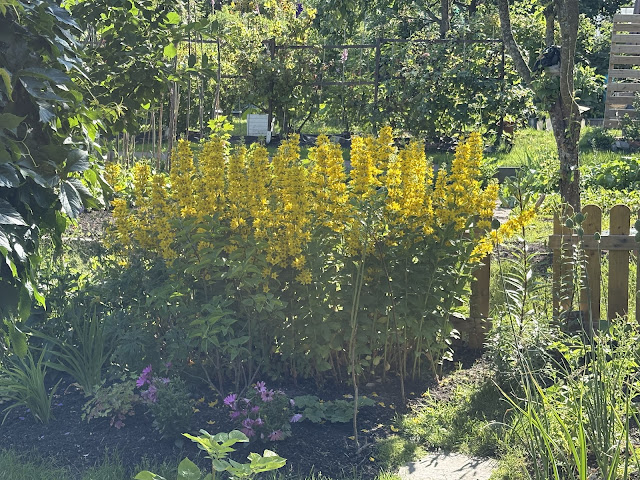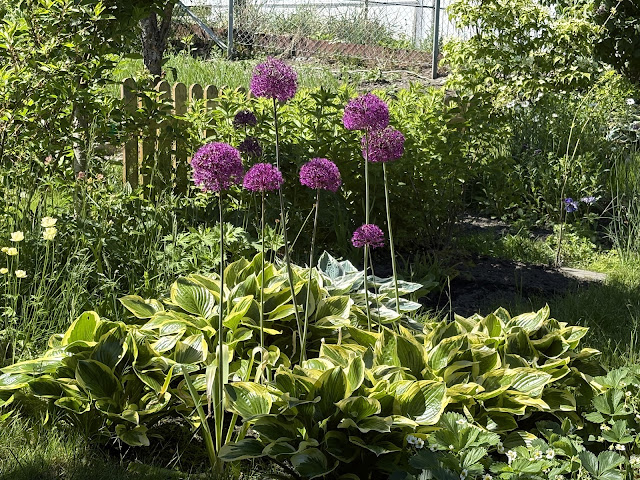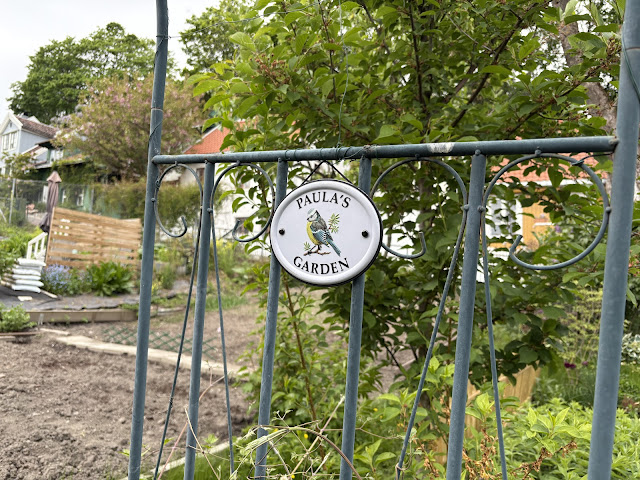Tuesday, December 30, 2025
My little garden friend
Tuesday, November 4, 2025
Halloween event at Frøyas Have in Oslo
Saturday, October 25, 2025
Autumn in Oslo and in my garden--October 2025
 |
| Gamle Aker church |
 |
| 'Karl Johan' main path in our allotment garden |
 |
| my Japanese maple tree, growing happily |
 |
| my allotment garden, facing Telthusbakken |
 |
| some plants are still growing and blooming |
Wednesday, July 2, 2025
Garden update
I've been working in my garden since mid-May. I tried doing garden work a couple of weeks after I came home from the hospital in mid-April, but I became dizzy and had to stop. Now, almost three months after my operation, I'm back to working in the garden for hours at a time. But I take precautions--sun umbrella up, wearing a hat to protect against too much sun, drinking a lot of water and resting when I get tired. We've had intervals of sun and rain, which has been very good for the garden, especially the berry bushes. There will be good harvests for black currants, gooseberries, raspberries, and strawberries. I've planted a cranberry bush that is thriving, and my Norwegian blueberry bushes are also happy. The American blueberry bushes, less so, so I ended up transplanting them to a sunnier location.
Yellow loosestrife has overtaken a large area of one of my perennial spaces. I cut it back but it just keeps on coming. It's beautiful, but I need to keep it in check or else it will take over the entire space. That seems to be my job this year--keeping growth in check. Everything is doing well and I can't complain. But maintenance of the garden keeps me busy. I'm very glad that I decided to aim for a (mostly) perennial garden, because I don't have to worry about buying a lot of annuals each year. The bushes that have grown the most since I planted them three years ago are the forsythia bushes. I cannot believe how large they've become. Ditto for the lilac bush. And of course the ninebark bush, which resembles a tree at present. I could clip it right down to the base, and it would grow back happily. I don't do that though; I clip a number of branches to keep it in a certain shape. And the Japanese maple tree is thriving as well, which makes me happy; it is so lovely.
The wild cherry tree that decided to take root from seed in my garden (I didn't plant it) has grown quite tall. It produces sour cherries, but not as many as the cherry tree I bought and planted. The birds (blackbirds, brown thrushes, sparrows) are eagerly waiting for the red currants to be ripe; each year it's a contest between humans and birds to see who gets the most red currants. Last year, we managed to pluck half of the berries, but the birds got the other half. They don't seem to go after the other berries as much. I don't know why.
My garden is thriving, if a bit overgrown in places. I like it that way. It's as though I enter my own private secret garden when I arrive there. Except for the formal garden entrance (an arch covered with white clematis), the other three sides of the garden are 'walled-in' by growth along the street fence, tall raspberry bushes, and black currant bushes plus a 'krossved' (Viburnum opulus) bush.
Here are some garden photos from May and June.......enjoy!
 |
| Beautiful wisteria |
 |
| Japanese maple |
 |
| Irises |
 |
| Rhododendron |
 |
| Ninebark bush |
 |
| Blooming peony plant |
 |
| Loosestrife |
Tuesday, December 17, 2024
Making friends with a little robin
One of the best things that ever happened in my life so far was being gifted an allotment garden in 2016. It changed and enhanced my life in so many ways that I never thought possible. I always had an appreciation for nature, for plants and flowers, and for birds and the wildlife around us, but I never had daily contact with them in the way that I do now. As many of my readers know, I have a soft spot in my heart for honeybees, bumblebees and birds of all kinds. One of the images that will forever stand out in my mind is the memory of the honeybees and sparrows side by side on the birdbath rim, drinking water together during a particularly dry Oslo summer (2018 if I remember correctly). I have captured those incredible moments in photos that I treasure.
Fast forward to the present. I have written about the new bird feeding station that I bought for my garden so that I can feed the birds during the winter months. I go to the garden every couple of days now to fill the different feeders. It didn't take long for the small birds to discover the feeding station; after a couple of days, they are waiting in the tree branches for me to fill the empty feeders, that's how fast they eat the seeds. The little birds that frequent the feeders are the sparrows, the blue tits, and a singular robin. The robins that you see here in Norway (European robins) are much smaller versions of their American counterparts, and they are amazingly cute. I read online that it's usually the male robin who stays put during the winter months at the location where he and his mate hang out during the summer months. So I'm assuming this little guy that I see each day is the male; I don't know if he has a mate and where she may be if he does have one. In any case, I'm becoming friends with him little by little. He is not afraid of me at all. Today, when I arrived to fill the feeders, he landed on one of them right in front of me and proceeded to start eating. He looked at me, then at the food, then at me, and then at the food again. He is the first one there when I arrive, and if I move away from the feeder to another part of the garden, he follows me. He is just so freaking cute. When I was in the greenhouse today, he was in the ninebark tree to the left of the greenhouse, just sitting in the branches. When I started to talk to him, he started to warble. I have heard his song before in previous springs, and I have seen this little guy before because he has been hanging around my garden for a couple of years. I'm glad that he chose my garden in which to hang around.
Here's a very short video of him:
Monday, December 16, 2024
This morning's beautiful 'mother of pearl' clouds (perlemorskyer)
December fun in Oslo
A week ago this past Sunday, I was out walking during the early afternoon, and came across these two very different activities. Both looked like fun! The weather so far this December has been wonderfully mild and sunny, so it was possible to do both these things because there was no ice or snow. I took these videos--enjoy!
Monday, December 9, 2024
Keeping the birds happy in winter
I recently purchased a bird feeding station from Amazon UK that arrived this past week. I love it already, since it was easy to assemble and came with different accessories, among them a suet ball cage, two pans (one for seeds and one for water), and a vertical hanging feeder. I am using both pans for seeds and/or bread cubes since there are freezing temperatures now and the water would just freeze in the pan. I had no problem assembling and installing it in my garden; it's placed under the krossved tree. The small birds have already discovered it and are making good use of it. I'm surprised I haven't thought of doing this before; we already feed the pigeons and magpies that show up outside our kitchen window in the morning--year-round. Sometimes the little birds show up as well, but they can't compete with the larger birds. Now they have their own feeding station that will hopefully keep them happy (and alive) during the cold winter months. Here is a photo of the bird feeder; I've already posted a link to it on Amazon UK for those who might want to buy the same feeder.
Monday, November 25, 2024
Caring for the birds in winter
Monday, November 4, 2024
Fjord Oslo Light Show
We went to see the Fjord Oslo Light Show (FJORD OSLO) this past Saturday evening, along with many others. Aker Brygge and Tjuvholmen were crowded with young and old people alike, all wanting to see the cool light installations placed strategically along the harbor area.
I'm glad I got a chance to see it. It's a great use of the darkness that descends upon this country at this time of year. The darkness is very dark, if you get my drift, and the lights light up the darkness in a wonderful and comforting way. Plus there's something fun about being together with other people, all of whom want to see the same thing. It was a chilly night, but we found our way to a nearby Italian restaurant afterward where we could warm up and eat a good dinner.
Here are some photos that I took. I'll post some videos in my next post.
Photos from our travels in north Norway this past July
As promised, and long overdue, here are some photos from our memorable trip to north Norway this past July. I wrote a post about our travels...








































